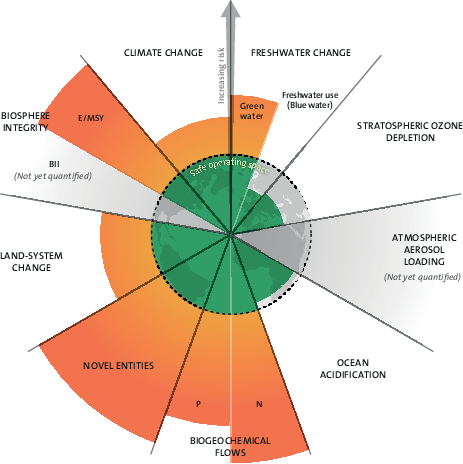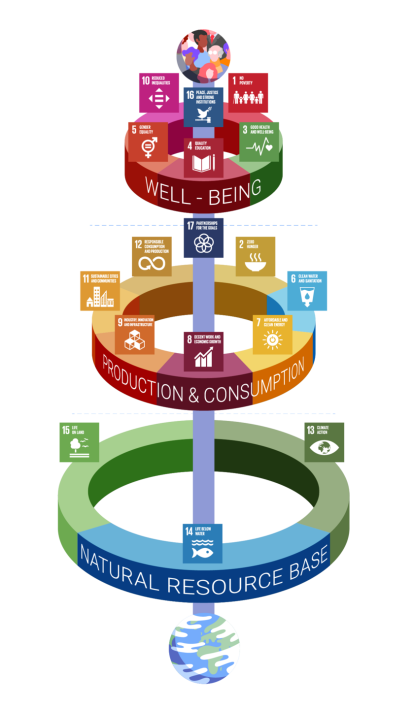Sustainable development – what it is?
The legacy of the industrial revolution that began in the 18th century is highly controversial. On the one hand, it has led to unprecedented prosperity worldwide. On the other, it has guided us to a deepening environmental crisis manifested in resource scarcity, environmental pollution, biodiversity loss and climate change. The Great Acceleration after the Second World War amplified these trends even further. We have already crossed six of the Earth’s nine planetary boundaries (see figure 1). It means that human society’s ability to function as it has been doing to date is increasingly called into question.
In 1987, the Brundtland Commission formulated the central idea of sustainability: the world must remain at least as good for future generations as it is today. We need to realise that we cannot go on as before, and we have less and less time to find new appropriate solutions.
Sustainable development in Estonia
Planetary boundaries
The situation is summarised by the Earth’s resilience thresholds or planetary boundaries model, created in 2009, describing the extent of human impact beyond which adverse environmental changes become irreversible. When the planetary boundaries are transgressed, human activities will threaten both the functioning of the ecosystem and people’s livelihoods. Changes with a global impact, where exceeding the planetary boundaries could have a strong negative impact on the Earth’s ecosystem and human livelihoods, include:

Figure 1. Planetary boundaries. Source: Azote for Stockholm Resilience Centre, based on Wang-Erlandsson et al 2022
Why sustainable development?
There has been much talk in Estonia recently about the green transition. However, this concept remains narrow and sometimes tends to silence the debate rather than promote it. Sustainable development is a broader concept: it means a balance between human and social well-being, cultural vitality, economic sustainability and the preservation and recovery of the natural environment in the long term. The coherence of these spheres is the basis for the UN Sustainable Development Goals and the goals of the Estonia 2035 strategy.

The current and future generations’ quality of life depends on a network of consumption and production, which in turn rely on the resources and benefits received from the natural environment. Unfortunately, today’s growth-oriented linear economy is increasingly exploiting natural resources and dumping emissions and waste back into the environment. The links between the economy and the natural environment vary from country to country. While some countries have succeeded in making economic growth less dependent on the extraction of resources (so-called ‘decoupling’), the world as a whole has not (see GlobalMaterialFlows.net). According to critics, even the progress so far is insufficient. They say there is no sign of a rapid, global, sustained decoupling of economic growth from environmental pressure (see Parrique et al. 2019).
The accumulating crises, from the Covid-19 pandemic to the energy and security crises, against the backdrop of the ever-worsening climate change call for action. Reports and books on how to turn the planet and humanity into a sustainable development path have been published for decades. For example, Silent Spring (1962), The Limits to Growth (1972) by the Club of Rome, the Brundtland Report (1987), the UN sustainable development action plan “Agenda 21” (1992), the UN environmental programme UNEP 2021, and Earth for All, the new publication commissioned by the Club of Rome (2022). Nevertheless, the data clearly show that humanity has been slow in planning and implementing change, and has become stuck in contradictions (see, for example UN 2022; Report of the Green Policy Expert Group 2022 of the Government Office of Estonia).
In 2021, for example, greenhouse gas emissions from the energy sector were the highest in history and 17% of all the food available to consumers was wasted (UN 2022). We have already reached the “red zone” for six planetary boundaries, which means we live in a society of overproduction and overconsumption where benefits are unequally distributed among people. Global data show that production and consumption can increase the Happiness Index and the Human Development Index only up to a certain point, beyond which the material footprint continues to grow, but welfare will not.
Sustainable development in Estonia
In a global comparison, Estonia belongs to countries where human development and happiness indicators are relatively high, but resource use per product or service is high. (Global Material Flows). Recycling municipal waste and developing a circular economy are still in their infancy here. While the target agreed in the European Union requires 55% of municipal waste to be reused by 2025, data from Statistics Estonia show that a few years ago, Estonia managed to recycle a third of it barely. The energy crisis has once again made our electricity production one of the most CO2-intensive in Europe (see Electricitymaps.com), our motorisation rate is among the highest in Europe (see Vehicles in ... 2022), and air pollution causes nearly 1,200 premature deaths a year and reduces life expectancy by 12 years in at-risk groups (Välisõhu kvaliteedi... 2022). For information on how Estonia is doing in sustainable development according to official statistics, see Tõetamm.
But just listing the problems will not get us much further. Estonia certainly has many advantages. Climate change will not make our land uninhabitable in the near future, our people have a genuine and close relationship and connection with nature, they still know how to make things themselves, digital technology opens up many opportunities, and our people generally believe in science and education. The recent Estonian Environmental Awareness Survey showed that 62% of the respondents supported “reducing production and consumption in society”. This is easier said than done. So working with scientists to find and test smart solutions is more necessary than ever. To bring together researchers from different fields of science and non-university partners, we have founded the University of Tartu Centre for Sustainable Development.


